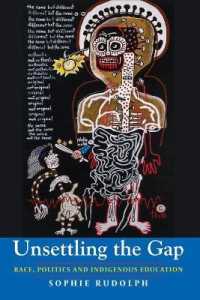- ホーム
- > 洋書
- > 英文書
- > Nature / Ecology
基本説明
The studies in this book move from the dream of ecotourism-fuelled development supporting nature conservation, towards the local realities of marginalized people in marginal environments on the edge of national parks and protected areas.
Full Description
The introduction of transfrontier conservation areas (TFCAs) in southern Africa was based on an enchanting promise: simultaneously contributing to global biodiversity conservation initiatives, regional peace and integration, and the sustainable socio-economic development of rural communities. Cross-border collaboration and eco-tourism became seen as the vehicles of this promise, which would enhance regional peace and stability along the way. However, as these highly political projects take shape, conservation and development policymaking progressively shifts from the national to regional and global arenas, and the peoples most affected by TFCA formation tend to disappear from view.
This book focuses on the forgotten people displaced by, or living on the edge of, protected wildlife areas. It moves beyond the grand 'enchanting promise' of conservation and development across frontiers, and unfounded notions of TFCAs as integrated social-ecological systems. Peoples' dependency on natural resources - the specific combination of crop cultivation, livestock keeping and natural resource harvesting activities - varies enormously along the conservation frontier, as does their reliance on resources on the other side of the conservation boundary. Hence, the studies in this book move from the dream of eco-tourism-fuelled development supporting nature conservation and people towards the local realities facing marginalized people, living adjacent to protected areas in environments often poorly suited to agriculture.
Contents
Foreword. Professor Marshall W. Murphree. 1. People at Wildlife Frontiers in Southern Africa 2. TFCAs and the Invisible Peoples 3. Defining the Edge: Boundary Formation and TFCAs in Southern Africa 4. Population and Livelihoods on the Edge 5. Ethnic Heterogeneity and its Implications for Natural Resources Management on the Edge 6. On the Edge of State and Economy 7. Resource Gradients and Movements Across the Edge of Transfrontier Parks 8. Consequences of Animals Crossing the Edges of Transfrontier Parks 9. Land and Natural Resource-Based Livelihood Opportunities in Transfrontier Conservation Areas 10. Whither TFCAs and People on the Edge in Southern Africa? Index








